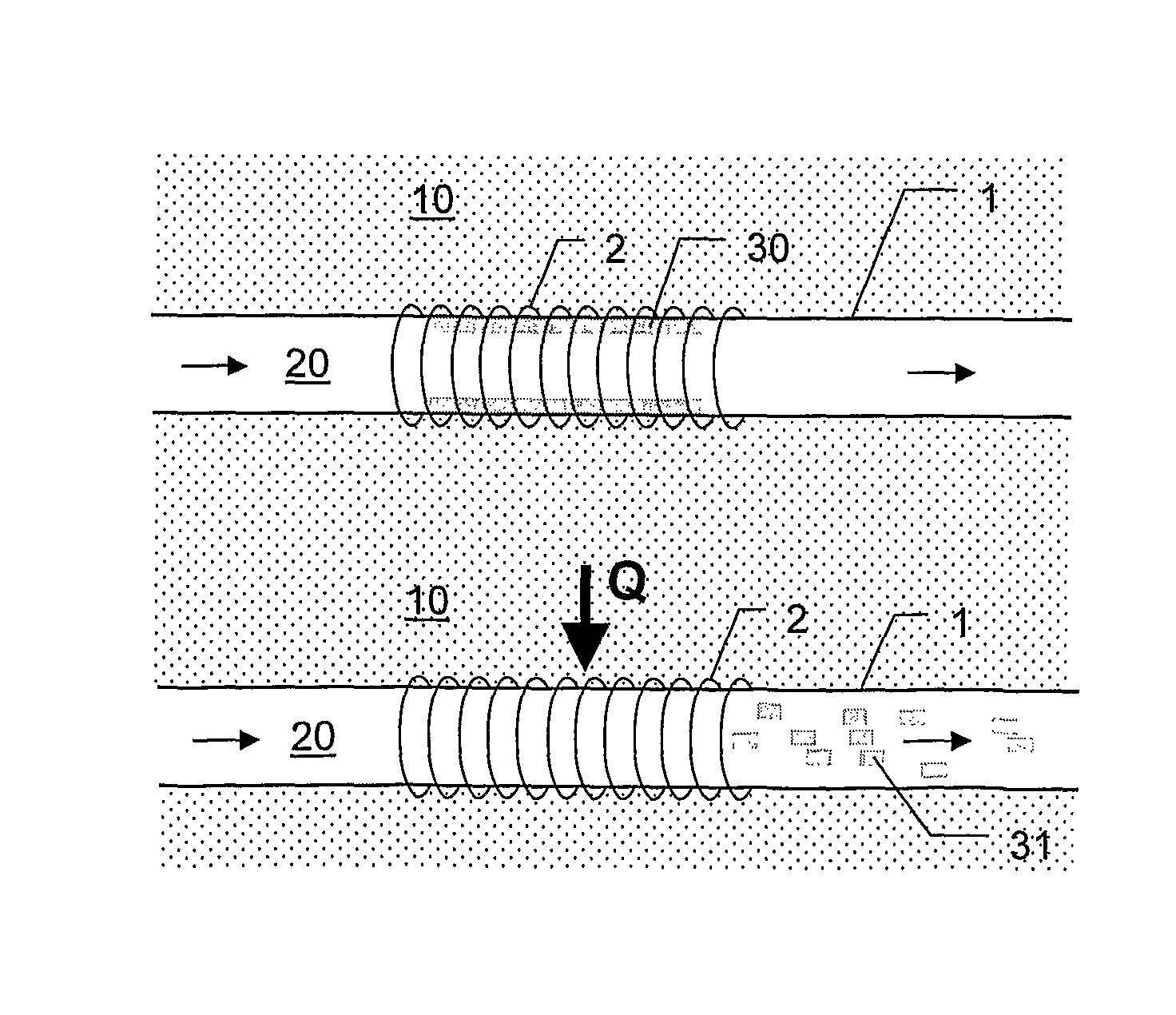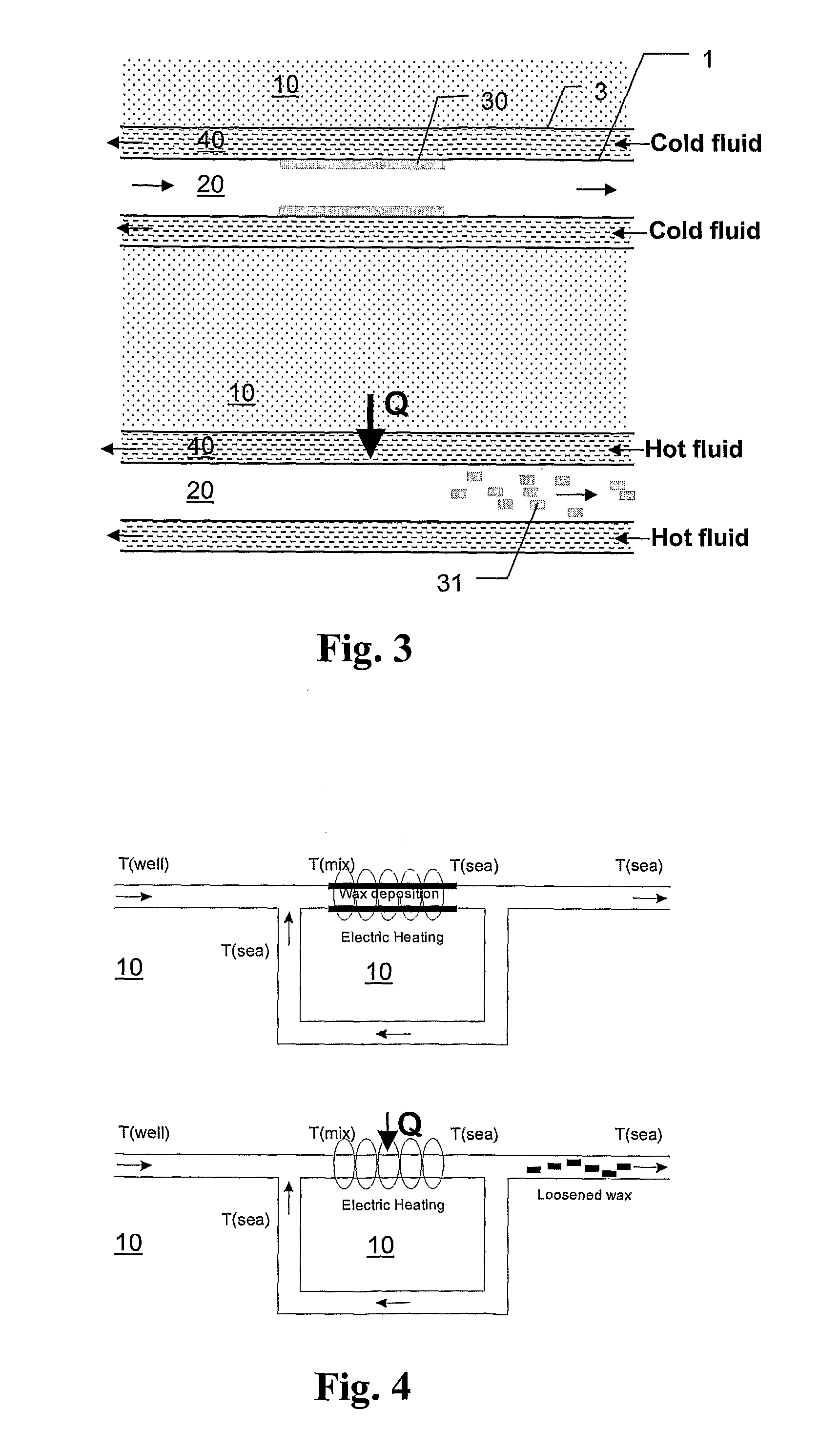Method for wax removal and measurement of wax thickness
a technology of measurement method and wax removal, applied in the direction of cleaning using liquids, insulation, borehole/well accessories, etc., can solve the problems of reducing the cross-sectional area of the pipeline, affecting the installation and operation of the pipeline, and accumulating wax at the inside wall of the pipeline. , to achieve the effect of cost-effective installation and operation
- Summary
- Abstract
- Description
- Claims
- Application Information
AI Technical Summary
Benefits of technology
Problems solved by technology
Method used
Image
Examples
example 1
[0065]FIG. 1 shows the results from an experiment in a wax rig at StatoilHydro Research Centre, Porsgrunn, Norway: A waxy condensate is circulated at constant temperature (20° C.) through a rig. The rig is cooled from the outside by a water annulus.
[0066]During the first 17 days, the water in the annulus was at 10° C., stimulating a continuous build-up of wax in the rig.
[0067]After 17 days the water temperature was increased to 15° C. so that the temperature difference between condensate / water was reduced. This made the wax-build-up slower.
[0068]After 22 days the water temperature was increased to 20° C. so that the temperature between water and condensate was the same. After 1 day the wax that was previously deposited suddenly loosened and was transported downstream with the condensate. After stopping and opening the rig it was found to be clean without any wax at the walls.
[0069]An explanation for the loosening is that, while increasing the wall temperature the wax structure near ...
example 2
Saturn Cold Flow
[0072]The Saturn technology is, in short, a technique based on the idea that dry hydrate and wax particles can be transportable and non-agglomerating during flow and shut-down conditions, further described in WO 2004 / 059178. By recirculating a cold slip-stream of hydrocarbon fluids with hydrate / wax particles into the hot well stream as shown in FIG. 4, dry hydrate / wax particles should form by ‘crash-cooling’ as slurry particles in the bulk in a reaction zone in stead of precipitating on the wall, and the fluids are cooled to ambient temperature in the vicinity of the reaction zone. Hence no deposition on pipe walls and blockage should occur when the slurry particles are further transported with gas and oil for long distances, after the splitter.
[0073]However, if the recirculated cold stream is to be mixed with the warm well stream close to the production manifold, to avoid wax deposition and hydrate formation during shut-downs, the temperature close to the mixing poi...
example 3
[0088]This principle has been proven in a wax rig, reference being made to FIGS. 11 and 12.
[0089]The heat pulse may be for example applied by an electric heating cable that is switched on for a short time or by a water annulus that is flooded with hot water for a short time. In the experiment shown in FIGS. 11 and 12, a temperature difference of only 10° C. between the oil and the water in the annulus was sufficient to provide reasonable results.
[0090]In this experiment, the temperatures were measured directly in the oil bulk flow. This is not desirable in a production environment. An alternative would be to measure the (outer) pipe wall temperature which provides the same information as shown in FIG. 12. In the alternative case of using hot water in an annulus, it is also possible to monitor the water temperature and the temperature drop from inlet to outlet during the heat pulse, as shown in FIG. 10.
[0091]Experiment performed in Wax Rig: Oil is circulated for one week at constant ...
PUM
| Property | Measurement | Unit |
|---|---|---|
| constant temperature | aaaaa | aaaaa |
| temperature | aaaaa | aaaaa |
| temperature | aaaaa | aaaaa |
Abstract
Description
Claims
Application Information
 Login to View More
Login to View More - R&D
- Intellectual Property
- Life Sciences
- Materials
- Tech Scout
- Unparalleled Data Quality
- Higher Quality Content
- 60% Fewer Hallucinations
Browse by: Latest US Patents, China's latest patents, Technical Efficacy Thesaurus, Application Domain, Technology Topic, Popular Technical Reports.
© 2025 PatSnap. All rights reserved.Legal|Privacy policy|Modern Slavery Act Transparency Statement|Sitemap|About US| Contact US: help@patsnap.com



